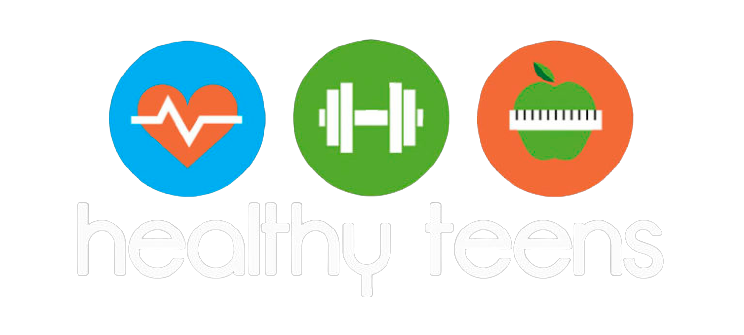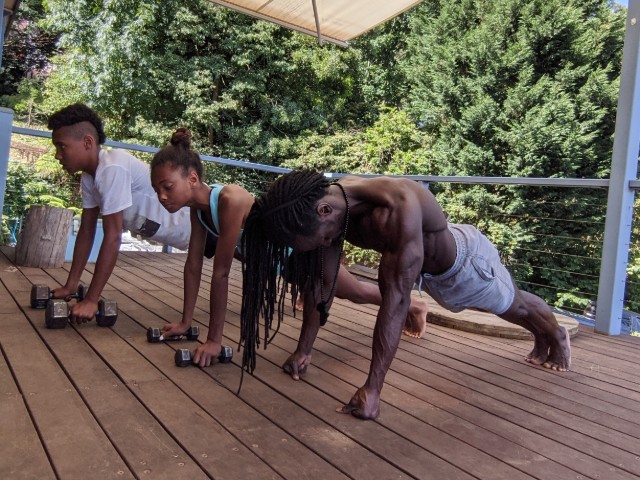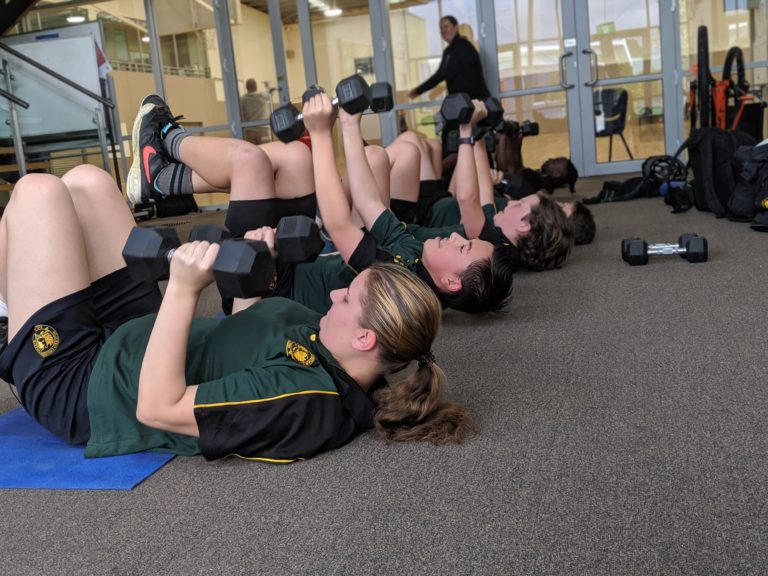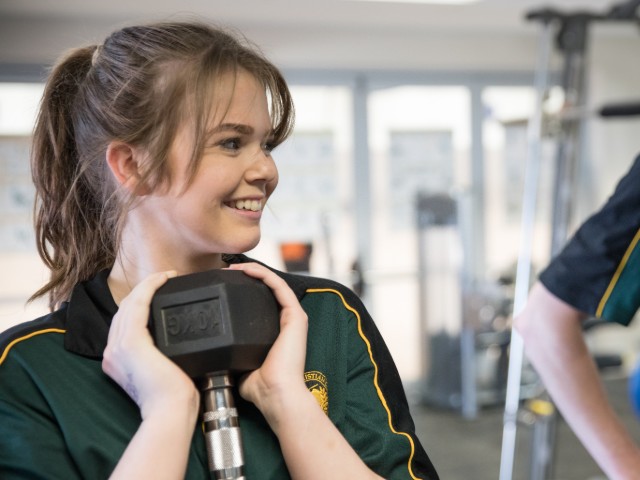
What drove you to create Healthy Teens?
Healthy Teens was formed to give teens the opportunity to improve their fitness with the assistance and guidance of trained professionals at school. Our goal is to create a fun, high-energy environment where teens can learn proper fitness techniques, train towards a set goal or simply improve their overall health and wellbeing.
What is the main benefit of fitness training?
The human body was designed for movement and activity. Engaging in regular exercises will strengthen your teen’s body, improve their muscular endurance, build their cardiovascular strength as well and flexibility. Lean muscle burns energy better than adipose tissue. Thus the more lean muscle tissue your teen has, the more energy they will burn daily. The following exercises all assist in building strength: pull-ups, push-ups, rowing, running, squats, abdominal crunches, biking riding, resistance weight exercises, dancing, ballet, various forms of martial arts, yoga, gymnastics and many more.
Is weightlifting safe for teenagers?
Weightlifting can be safe for teenagers, as long as they follow proper form and use appropriate weight loads. It is important to start with light weights and gradually increase the weight as strength and ability improve.
Will resistance training stunt the growth of students?
Resistance training otherwise known as strength training is a vital part of a balanced exercise routine that includes aerobic activities and flexibility exercises. It is a safe and effective way to strengthen muscles, tone the body, strengthen bones and increase vitality. One of the biggest myths about resistance training is that it stunts growth. No study has ever shown that lifting moderate weights stunts or inhibits growth. Students have more of a chance of damaging their growth plates though involvement in high contact sport such as AFL, than training with resistance weights. Like any physical activity, this type of exercise is not dangerous if conducted with proper supervision and instruction. The most important aspects when it comes to resistance training are supervision, exercise prescription and technique, light weights to begin with and a high repetition range.
How often should my teenager lift weights?
The frequency of weightlifting sessions will depend on the individual and their goals. A good starting point is to lift weights two to three times per week, with at least one day of rest in between sessions.
Should my teenager use supplements or protein powder?
It is not necessary for teenagers to use supplements or protein powder in order to see results from weightlifting. A balanced diet that includes plenty of protein, carbohydrates, and healthy fats can provide all the nutrients needed for muscle growth and recovery.
What if my teen hasn’t done much exercise before?
Our mission is to ensure health and wellbeing is at the forefront of your child’s education. Safety is what we are about. Signing up to our program will grant your teen access to the following: customised training programs, correct technique and form instruction, accountability, motivation as well as nutritional advice and tips to help them on their way. We’ve dedicated some time strictly for beginners to allow them to build on their strength as well as confidence. There is no substitute to having a trainer by their side; guiding them through their workouts. Our aim is to help your teen accomplish their goals.
What are the qualifications of your staff?
Healthyteens.com.au is committed to developing healthy habits in our youth by ensuring learned habits progress with them throughout their lives. Our staff are all experts in their field. Qualifications range from Personal Training Certificates, associated Health Degrees to Doctorates. You can be assured that your teens are in good hands.
How are your training programs created?
Each teen is unique. The main focus of our programs is to provide participants with tailored sessions in accordance to their needs. Does your teen have a specific goal? Do they need to increase their cardiovascular endurance for an upcoming event? Are they trying to shave a few seconds off their best sprinting time? We are here to help. Our staff are all qualified professionals who have the best interest of your teen at heart. Our programs have been designed to get your kids moving as well as help them feel great. We oversee the development of all our programs and continually make adjustments where necessary.
What important things does my teen need to consider before taking on a new exercise regime?
If exercise is foreign to your teen, there are three things worth considering to make this endeavor worthwhile: diet, exercise and motivation. The easiest place to start is your teen’s diet. They will need to focus on fueling their body with the right nutrition. Steps such as cutting down their junk food consumption, eating clean proteins (lean red meats, poultry, fish beans and nuts) as well as fruits, dark vegetables and whole grains will definitely help. Following a couple of easy rules such as staying away from white bread (all the good fibers have been stripped away during the preparation process), and eating their vegetables raw where possible (so they avoid the loss of enzymes from cooking), will help to give their body the fuel it needs to train efficiently.
Here is a tip: where possible, your teen should consume foods that are low GI. Additionally, they should snack on healthy foods, fruits and vegetables rather than chips, cookies, chocolates and sweets. As always, it’s a great idea to chat with their doctor about any health recommendations made by Healthy Teens or any other organisation.
Next, they will need to exercise! This is obviously an important step as it helps burn calories and increase muscle tone. Mixing their resistance training sets with bursts of cardio exercises will heat up their core temperature as well as improve their circulation. Exercising regularly will improve their muscular strength as well as increase their metabolism. This will assist in burning calories faster over time.
Lastly, they will have to do this in right frame of mind. This is the most critical element in my opinion. They will have to be ready, willing as well as motivated to do what it takes to reach their end goal. Their resident trainer will be able to assist them with this. Without getting this right, the road ahead will be much harder than it needs to be.
What can my teen expect from participating in your programs?
Within six weeks of signing up, your teen will certainly feel stronger with a desire to stay physically active. Boys will start to look toned and will see a difference in muscle size and strength. Girls will note changes in their fitness and their confidence will begin to increase. Whatever your teen’s goal; be it to boost their self-confidence and physical fitness, increase their sense of well-being, achieve a range of health, fitness and wellbeing goals, have loads of fun with like-minded people; we’ll get them there!
What elements do the best exercise routines contain?
As we all know, fitness is a lifestyle choice. In our opinion, when it comes to increasing the overall health of your teen, the best exercise routine should consist of three components: aerobics, strength training and flexibility. Including these elements into their routine is a great way to get their hearts pumping, increase their muscular strength whilst ensuring their bodies stay nimble. By exercising regularly and making smart food choices, your teens will not only look better, but more importantly, feel better.
How do I know what sports is best for my teen?
When it comes to choosing a sport, we strongly encourage they pick something which they find of interest. Like anything in life, once their passion is ignited, success always follows. Great questions worth discussing with your teens are as follows:
If they are unsure about any of these questions, their resident trainer will be more than happy to assist in working out what sport is right for them. Together with your guidance, I’m positive they will choose the right path for them.
Should my teen use heavy weights?
At the beginning of our program, we recommend light weights for all teens; focusing on form and repetition. Our rule of thumb is to start them off with a weight that they can easily lift 15 times, with the last two repetitions being increasingly difficult. For some teens, this might be only 2kgs. This is ok! Once we work out where your teen’s strength lies, we will be able to increase this. Note: Unless your teen is enrolled in a power lifting program or discussions have been had with your teen in your presence, we don’t actively encourage them to lift very heavy weights.
Will my girl build big muscles from resistance training?
This is one of the most commonly asked questions we receive. It would be tough for a female to build big muscles through resistance training, unless they focus specifically on power lifting exercises as well as submaximal repetitions. Why? Females naturally produce less testosterone (male reproductive hormone) than males. As a result, their muscle size typically builds at a much slower rate.
How important is technique when training?
Technique is EVERYTHING! We at Healthy Teens can’t stress this enough. Weights training may look easy to the untrained eye, but to be done effectively, time must be spent learning how each exercise should be conducted. Some of the most common exercises such as sit-ups are the easiest to get wrong. If your teen doesn’t use the correct form, they can find themselves engaging all the wrong muscles.
For instance; old school crunches should be done lying flat on the floor with bent knees, keeping your feet close to your buttocks. Support the weight of your head with your hands clasped behind your head, but don’t push with your hands. Come up slowly, from the shoulders through the upper back to the lower back, aiming to keep your back straight and using the power of your stomach muscles to move. Come up no more than 30 degrees to start with. Avoid twisting or jerking movements. Then return to the starting position slowly and with control.
When done correctly, weight training will increase the strength and muscle tone of your teen, while improving their overall fitness.
What is the purpose of the weights gym?
The purpose of a weights gym in schools is to provide a space for students to engage in physical activity and strength training. The gym can serve as a resource for students to improve their physical fitness, build muscle strength, and increase endurance. Weight training is also beneficial for bone health, balance, and coordination, making it an essential part of a well-rounded physical education program.
In addition to the physical benefits, a weights gym can also provide a space for students to socialize and build relationships with peers who share similar interests. It can also help instill healthy habits and promote a lifelong commitment to physical fitness.
Overall, a weights gym in schools can be an important component of a comprehensive physical education program, helping students to develop physical and mental resilience, discipline, and a positive attitude towards health and fitness.
Comfortable clothing: Students should wear clothing that is comfortable and allows for a full range of motion. This may include athletic shorts, sweatpants, leggings, or athletic pants.
Athletic shoes: Students should wear athletic shoes with good support and traction. Running shoes or cross-training shoes are usually the best choice for weightlifting.
Avoid jewelry: Jewelry such as rings, bracelets, and necklaces should be removed before using the weights gym to avoid injury or damage to the equipment.
T-shirts or tank tops: Students can wear t-shirts or tank tops, but they should avoid clothing that is revealing or inappropriate.
Hair tied back: Long hair should be tied back to avoid getting caught in the equipment.
Avoid baggy clothing: Baggy clothing can get caught in the equipment and can also make it difficult to perform certain exercises. It is best to wear form-fitting clothing that allows for freedom of movement.
It is important for students to follow the dress code to ensure safety and avoid any accidents or injuries.



Trainer on Call is a fun and easy way to build healthy more productive teams.
We promote healthy workers that eat well, move more and live a healthy lifestyle, in line with government guidelines.